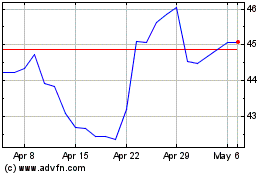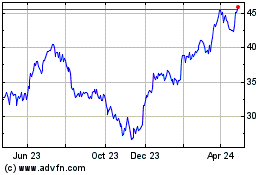By Mike Colias
General Motors Co. is betting its future on electric cars. By
mid-decade it plans to spend $27 billion on manufacturing 30
electric models and developing driverless cars. By 2035, it expects
to have phased out gasoline-engine options completely and to be
selling only electric vehicles, a technology that currently
generates about 2% of sales and no profit for the company.
Planning for this transformation at the factory level is the
responsibility of Gerald Johnson, a GM lifer who took over global
manufacturing operations in 2019, and who is spearheading a $2.2
billion gut rehab of a factory in Detroit, recently renamed Factory
Zero, to serve as GM's electric-vehicle hub. Two more conversions
of North American factories for production of electric vehicles, or
EVs, are in the works.
Mr. Johnson, 58 years old, calls it the most far-reaching
strategic shift he has seen in his career at GM, which he began 40
years ago as an intern.
"There has always been incremental change," he says. "This is
transformative."
GM factories around the world employ more than 100,000 workers.
Some plants exist solely to assemble gas-powered engines and
transmissions that won't be needed if the company successfully
reaches its 2035 target, portending big changes for both workers
and GM's factory footprint.
Addressing disruption is nothing new to Mr. Johnson, whose
duties have included managing labor relations through a bitter
40-day strike at GM's U.S. factories in 2019 that drained $3.5
billion in profit. Last spring, his team led GM's effort to make
ventilators after Covid-19 hit the U.S., closing car factories for
nearly two months. Now, continuing supply-chain disruptions are
hampering efforts to make up for lost output.
The Wall Street Journal talked to Mr. Johnson recently. Here are
edited excerpts.
WSJ: Electric cars are breaking down some of the barriers to
entry that have protected big car companies. How can GM maintain
its edge?
MR. JOHNSON: From an engineering standpoint, electric vehicles
of course require a lot of technology and innovation. The holy
grail is finding that cost balance between electric range and the
cost of a battery.
But the integration [of GM's own electric powertrain into its
own car models, in effect producing everything in house] is the
piece that I think is going to enable us to run further and faster.
Integrating this technology into a vehicle platform in such a way
that allows all the functionality that we currently offer, but the
added capability of an EV -- that's where I think GM is going to
show out based on our track record.
WSJ: You're saying even though it has become easier for others
to put together battery systems and offer electric cars, there's
more to it than that?
MR. JOHNSON: Yes. There are the specific elements of figuring
out the technology cost curve, and we're doing that. But I think
where we will leapfrog others is on everything else that goes into
the vehicle. We think we have an advantage with our supply base,
with our ability to integrate our software capabilities. We also
have an established dealer network that can help us.
WSJ: GM is spending more than $2 billion to convert Factory Zero
to make EVs. What has to happen to make that conversion?
MR. JOHNSON: Other than the outside walls, everything in Factory
Zero is new. We're putting in a new body shop because we have to
tool for the new vehicles. There's a new paint shop, which is a
significant portion of the investment. And all-new conveyance
systems and automation. We're also doing things like putting in
solar panels to provide power to the grid. Factory Zero will not
just produce vehicles that are emissions-free; we're going to be
based on renewable energy in the factory as well.
WSJ: It has been a few decades since GM last built a new plant
in the U.S. What advantages come from starting with a clean
sheet?
MR. JOHNSON: First, the plant will build solely EVs, so we get
to optimize it for that. We don't have to carry what we would call
"scar tissue" of having a large engine-buildup area. And, because
the weight of an EV is greater, we'll need a more robust conveyance
system.
WSJ: Electric cars are less complex than gas cars and require
far fewer parts. How does that change the factory and what exactly
workers do?
MR. JOHNSON: Probably the biggest piece will be in an area that
would have been dedicated to engine buildup, when we bring an
engine in from one of our powertrain facilities and add all the
additional components. There's a whole line and area dedicated to
that, along with marrying it up to the transmission and
subsequently to the body of the vehicle.
Well, in the EV world, it's a battery pack. It's our Ultium
platform that rolls in and all marries up to the vehicle and makes
it even easier to integrate versus earlier versions of our EVs.
WSJ: How will workers' skills need to change?
MR. JOHNSON: There are two pieces. One is the ongoing innovation
that happens through automation and other work. Every year, with
every new vehicle program, we upgrade the technology it takes to
process a vehicle. That requires additional skilled trades and a
digital understanding.
The most impressive piece is the data analytics that are now
being embedded in the diagnostics that we use in our equipment.
That allows our operators to have a much richer understanding of
what's going on, what actions we need to take to keep the equipment
running.
WSJ: What about as you transition to making electrics and
eventually autonomous vehicles?
MR. JOHNSON: At a place like Factory Zero, we're going to have
multiple product programs that will take a higher level of
adaptability -- both in the tooling and in the kind of work that
they're going to have to be able to do, with longer cycles and more
variation.
WSJ: So workers on an assembly line may be performing more
complex tasks that take them longer per job than they might
today?
MR. JOHNSON: Exactly. The cycles will require more complexity of
execution per station and per operation. Versatility and
adaptability will be important because work flows will be different
in this environment.
WSJ: Given that EVs require less manpower, should workers be
worried about there being fewer auto factory jobs in that
future?
MR. JOHNSON: I think every GM employee should be excited about
what we're doing. Because we see our EV strategy in total as a
full-on growth strategy. We will expand. Yes, some job assignments
will change, but we will have opportunities for everyone to come
along with us as we make this transformation. There will be more
work available in that future than what we have today.
WSJ: The company sees electric vehicles as a growth play, rather
than simply replacing its gas-powered business?
MR. JOHNSON: This is all about growth for us. One reason is that
it allows us an opportunity in the markets where EVs are popular
and where we have the greatest opportunity to gain market share,
like on the West Coast, the East Coast and some portions of the
South.
WSJ: What have your discussions been like with the United Auto
Workers about the future workforce and how it's changing in this
transition?
MR. JOHNSON: Work at Factory Zero is going to start to produce
vehicles this year. We are always in conversation with our union
partners about what it's going to take and how we're going to work
together to bring this investment to life. We're going to allow
ourselves enough time to communicate effectively and plan for this
2035 future that we just committed to.
WSJ: GM is bullish on EVs. But what if the sales volumes fall
short? How do you manage that if you've set aside all this factory
capacity?
MR. JOHNSON: We've got a 15-year horizon. We think we've left
enough adaptability in our footprint to be able to meter that
transformation, where there's a good overlay between
internal-combustion vehicles and EVs. How it plays out between 2024
and 2030, for example, we've left ourselves some flexibility based
on market demand. We're confident in that end point. We're just not
sure how the mix will evolve to get to that.
WSJ: You led GM's effort to pivot to ventilator production last
spring when the plants shut down from the pandemic. What did you
learn about the organization from that?
MR. JOHNSON: We've coined the phrase "ventilator speed." That
means pulling together a team and breaking through barriers to get
something done. We see it now with the accelerated pace of
executing our EV strategy. Many of the programs that we've
announced of late, we've already pulled those dates ahead. That's
ventilator speed -- integrating the team in one location so they
can solve problems, and making sure all the resources are there, to
help them not to follow the process, but to follow the speed and
pace to deliver the outcome.
WSJ: Since you've come into this role, you have handled a
strike, the Covid shutdown and restart, and supply-chain disruption
that has affected production. What have you learned about leading
during times of upheaval?
MR. JOHNSON: What I've learned is that our teams are able to
handle it when you support them and focus them on the challenge of
the moment.
We launched a new SUV in Arlington, Texas, in the midst of the
pandemic hitting at the same time. We have accelerated our EV
programs.
My first plant-manager assignment, I pulled up to the plant, and
there were firetrucks all blocking the driveway. My first day and
the plant is burning, smoke billowing through it.
You learn how to problem-solve in the midst of crisis, and
communicate and protect people and focus on what must be done so
everyone can return safely. It's just manufacturing, it's just what
we do.
Mr. Colias is a reporter in The Wall Street Journal's Detroit
bureau. He can be reached at mike.colias@wsj.com.
(END) Dow Jones Newswires
February 20, 2021 11:14 ET (16:14 GMT)
Copyright (c) 2021 Dow Jones & Company, Inc.
General Motors (NYSE:GM)
Historical Stock Chart
From Mar 2024 to Apr 2024

General Motors (NYSE:GM)
Historical Stock Chart
From Apr 2023 to Apr 2024
